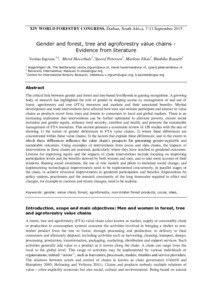Resource information
The critical link between gender and forest and tree-based livelihoods is gaining recognition. A growing
body of research has highlighted the role of gender in shaping access to, management of and use of forest, agroforestry and tree (FTA) resources and markets and their associated benefits. Myriad development and trade interventions have affected how men and women participate and interact in value chains as products travel from trees and forests to consumers in local and global markets. There is an increasing realisation that interventions can be further optimized to alleviate poverty, ensure social inclusion and gender equity, enhance food security, nutrition and health, and promote the sustainable management of FTA resources. This section presents a systematic review of 1 studies with the aim of showing 1) the nature of gender differences in FTA value chains; 2) where these differences are concentrated within these value chains; 3) the factors that explain these differences; and 4) the extent to which these differences influence the value chain’s prospects for generating gender - equitable and sustainable outcomes. Using examples of interventions from cocoa and shea chains, the impacts of interventions in these chains are assessed, particularly where they have resulted in gendered outcomes.
Lessons for improving equity and the impacts of chain interventions include focusing on improving participation levels and the benefits derived by both women and men, and to take more account of their relations. Raising social awareness, the use of role models and pilots to stimulate social change, and implementing technological improvements need to be implemented concurrently, in parallel stages of the chain, to achieve structural improvements in gendered participation and benefits. Expectations by policy makers, practitioners and the research community of the long timescales required to effect real changes, for example in customs and tenure changes, need to be realistic.







